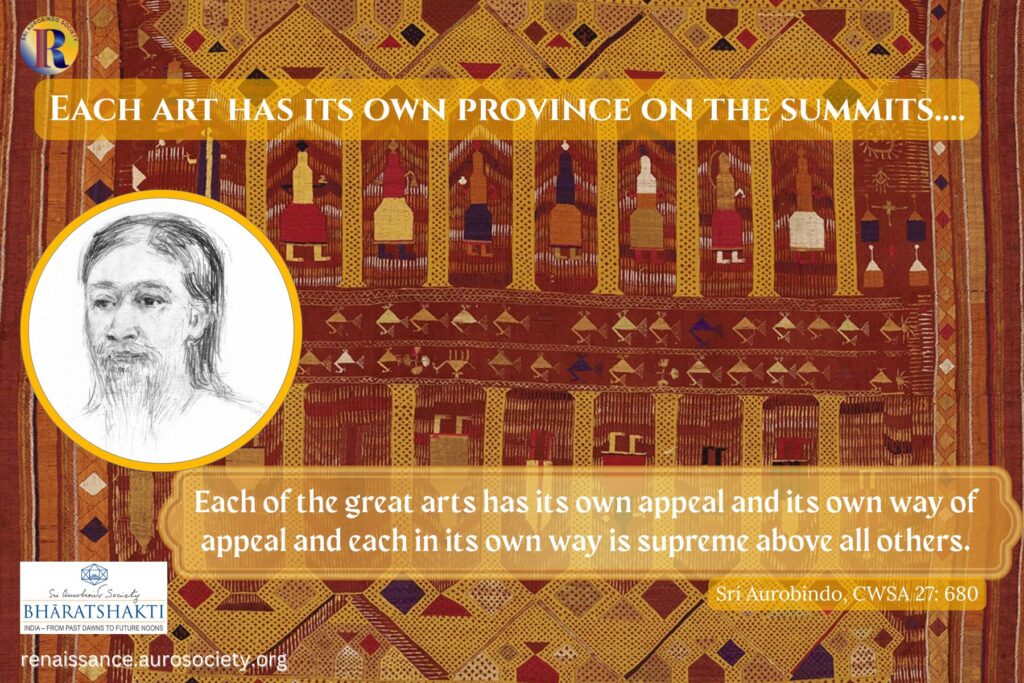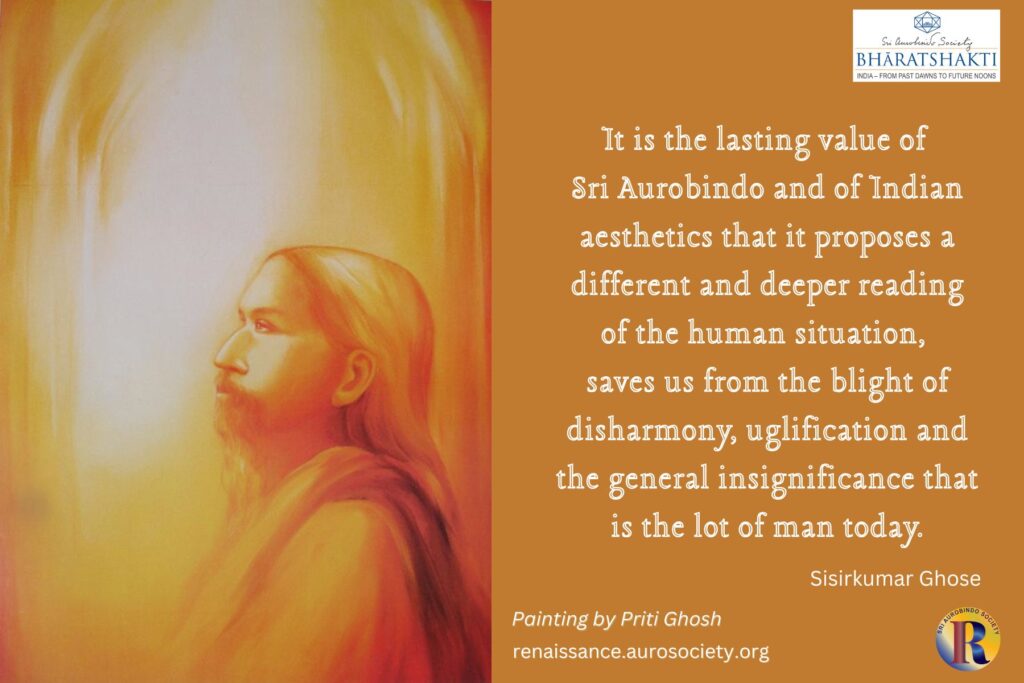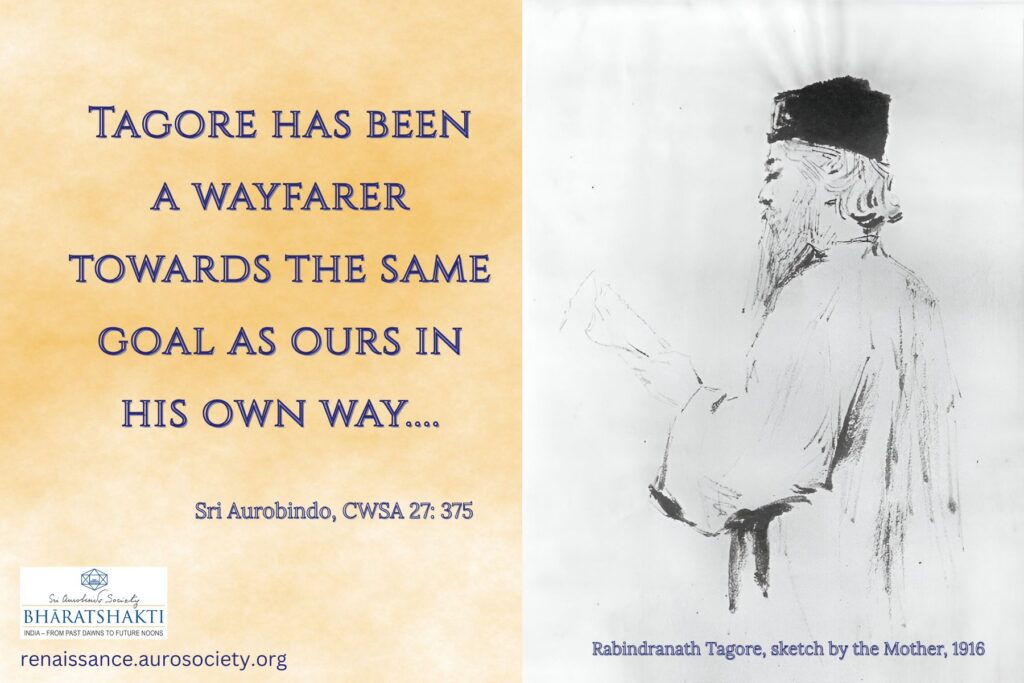Volume V, Issue 1
Author: Mangesh V. Nadkarni
CONTINUED FROM PART 1

Yoga of King Aswapati
In Vyasa’s story, Aswapati is a noble virtuous king who has all the benefits and blessings of life except progeny; he doesn’t have children. As it used to happen in earlier days, if one doesn’t have children, then one is not very sure that one will get a passport easily stamped to go into heaven. You have to have a son or a daughter at least. So Aswapati performs a yagna.
In the original story he performs a yagna for 18 years and each day he offers to goddess Savitri 10,000 oblations. Vyasa describes Aswapati’s tapasya in 10 lines. Sri Aurobindo has the section here on Aswapati’s yoga, and he devotes to Aswapati’s yoga 10,968 lines. So what Vyasa was able to convey in 10 lines, Sri Aurobindo requires 10,968 lines.
If you look at the contents page, Aswapati’s yoga begins on page 22, Canto 3 of Book 1, and ends with Canto 4 of Book 3, that makes 22 cantos. Why does he require all these lines? Is he describing each purohit, his girth, his height, his weight, how many purohits were there, or does he have a guest list, how many people are invited? No. Then you immediately begin to see that this is a different kind of enterprise, because the quest of Vyasa’s Aswapati was progeny, and the quest of Sri Aurobindo’s Aswapati is something entirely different.
His was a spirit that stooped from larger spheres
~ Sri Aurobindo, Savitri, Book I, Canto 3, CWSA, Vol. 33, p. 22
Into our province of ephemeral sight,
A colonist from immortality.
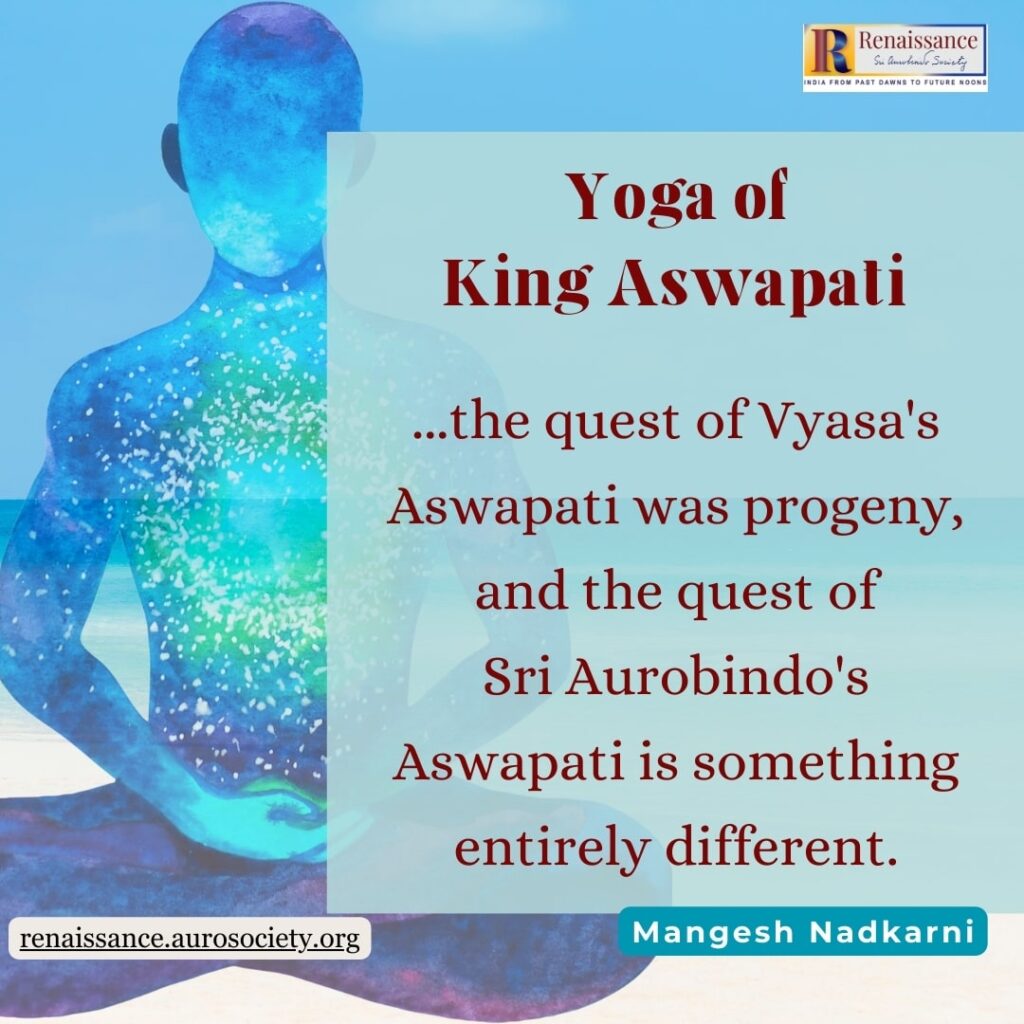
What was Sri Aurobindo’s Aswapati’s quest about?
Very briefly: the quest Sri Aurobindo had, which he pursued during the 40 years he spent in Pondicherry. What was Sri Aurobindo doing for 40 years? If you want to see an answer to this question, read Book 1 of Savitri, it will give you an answer.
Sri Aurobindo’s Aswapati is not an ancient king. The spirit of this Aswapati is as modern as a professor of Harvard or any Indian university, who is asking this question: Man has at his command all the sciences, all the technology, all the spiritual lore the East and the West have to give. We have the accumulated wisdom of several cultures and civilisations, and yet the load of suffering on the human head remains undiminished. Why?
Religion came, science came, and yet the agony, the pain, the injustice. It is only the location that is different.
Revolutions have come, the Russian revolution trying to bring in a paradise for the working man. After 80 years of this attempt to bring paradise, people said we don’t want this paradise. What happens? In the times of the Tsar there was such a great deal of exploitation in Russia; Marx wanted to eliminate all that. Did he succeed in doing that? Exploitation and the tendency to exploit remain undiminished, except the exploiters are different, the exploited are different, that is all.
Education has come, the education that we thought would change man, would transform the person.
Germany is a paradigm example of an educated nation. And yet one mad man called Hitler was able to brainwash a major part of Germany, and made decent Germans do horrible things. What guarantee has education that it will prevent you from being a beast? I don’t think education is a guarantee. Where is the answer?
We have philanthropy. Mother Theresa coming from Poland, working in the slums of Calcutta, was such a great lady—if I find her I’ll touch her feet—and yet the question is, how many more Mother Theresas are we going to need? We need Mother Theresa not only for Calcutta but everywhere, and if this Mother Theresa goes everywhere, do you think the tears in human eyes will disappear? That there won’t be any more exploited people? That there won’t be any more hungry people discarded on the garbage heap of society?
Where is the way out? Aswapati is asking this question.
Religion tells you that the world you want to change is like the dog’s tail, and the dog’s tail is crooked. A wise man is he who doesn’t waste his time in straightening out a dog’s tail. Then what should I do?
Get a railway guide, find out the shortest route to an ashram somewhere. Buy the ticket, go to the ashram, close your eyes, look within yourself. There you will find the Kingdom of God, you will find the world of sachchidananda. You find there is no turmoil, no revolution. Only peace, bliss, happiness. Shivoham, shivoham, everything is shubham satyam.
But when you go out, it is the same poverty, the same ugliness, the same exploitation. That is all mithya, that doesn’t exist. Reality is here within.
For Sri Aurobindo this answer is not acceptable.
I very often tell a little story to my friends. There are so many paths to realisation. First of all, you should have mumukshutvam, a strong desire for self-realisation. Then you must have vairagyam. How many lives does it require? Oh, it may require 10-15 lives before you get real mumukshutvam and real vairagyam. And then you turn within and find the Kingdom of God.
This is the way all our teachers have been telling us. You first of all have to get mumukshutvam, vairagyam, and then turn within and some day you will find the Kingdom of God and you will be alright. Great teachers came: Ramakrishna Paramahansa, Jiddu Krishnamurti, Ramana Maharshi, Sri Aurobindo himself was here. How many people directly benefited from their coming?
The Light from heaven keeps coming down; God is in love with this world, he keeps coming. We don’t seem to want him. Aswapati realises this.
Is there way out by which you can rid man of this stupidity, that when a Light comes he cannot even receive Light? This is not a medieval king performing a yagna for children, this is a question asking for fulfilment of life here on earth: that is Aswapati’s yoga.
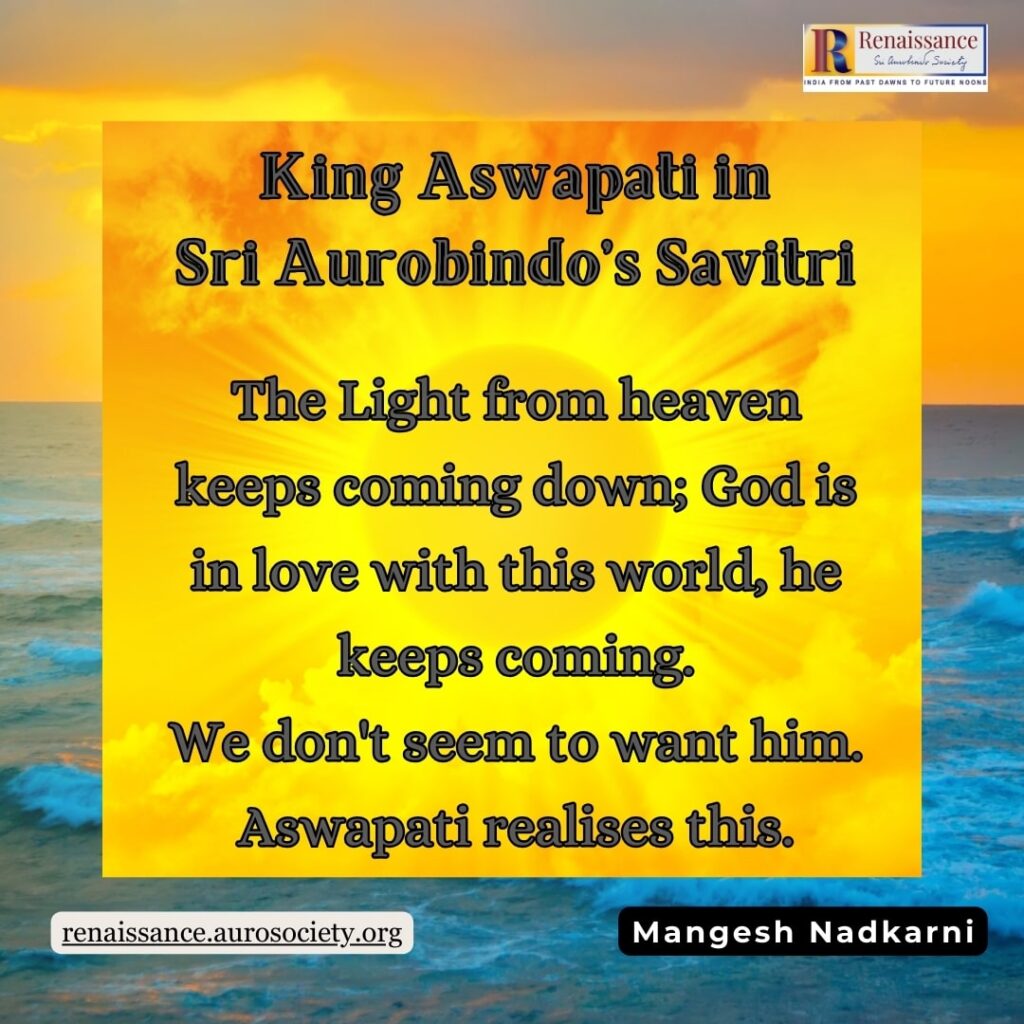
He is trying to find the answer to the question: “Is there a way out?”
We are not talking about saving one individual—that’s not the question—we are trying to save humanity as a whole. This was Aswapati’s quest. And naturally, as you can see, if this is your quest, then to find the answer to this question you cannot do it in 10 lines as Vyasa did. It requires 10,968 lines or even more.
I have a feeling that probably Sri Aurobindo meant Savitri to be 50,000 lines long. If there were more time, he probably would have enriched that part. And you can see that 10,968 lines is not a long stretch, if you want to condense this quest of Aswapati on behalf of mankind as a whole and find an answer to this quest.
This is, as one can see already, from a legend; this legend is now being used as a symbol.
Aswapati’s Symbolic Quest for All Humanity
Aswapati’s quest is a symbolic quest: it is the quest of humanity as a whole. This is a first change that one finds that Sri Aurobindo has made in Savitri.
The second change is that in the Mahabharata story, Savitri performs a vow called the triratra vow. For three nights and three days she undergoes a very rigorous vratham: standing in one place, not taking any food, etc., which Vyasa describes in eight lines. In Sri Aurobindo’s Savitri, this becomes Savitri’s yoga. Sri Aurobindo devotes to this the whole of Book 7, “The Book of Yoga,” which has seven cantos and all these seven cantos talk about Savitri’s yoga.
Very often people have said, “Aswapati’s yoga is Sri Aurobindo’s yoga, Savitri’s yoga is the Mother’s yoga”. This is a little too simplistic and too glib, but there can be seen some parallels of that kind. I won’t stick to it too much and say this is exactly what the Mother did, nothing more and nothing less. That is not a good way of going about it. But this is another change. Vyasa describes it in eight lines and Sri Aurobindo requires for it 100 pages and nearly 3000 lines. This is a second change.
Now the third development.
In the original story, Aswapati finds that no suitable young man has come forward to claim Savitri’s hand in marriage. And like the traditional Indian father, he too is very worried about his daughter’s marriage. She has come of age, so he sends her out into the open world to find a companion for life. Immediately after that, in the next scene, Savitri has already completed her journey and her quest, and she is coming back to her father to report to him that she has found the young man called Satyavan. This is the original story.
Savitri’s Quest for Love
Sri Aurobindo takes great interest in the quest itself. He describes the quest in great detail. For example, a major part of Book 4 is devoted to Savitri’s quest. Where did she go? What did she find? Here you have glorious descriptions of the various seasons, Sri Aurobindo’s favourite seasons being the spring and the monsoon.
The whole of Book 5 talks about love: where Satyavan and Savitri meet, how they recognise each other, how they discover each other, and how they enter into what is called gandharva vivaha. In the original story we find nothing of this; Sri Aurobindo takes great delight in describing this.
If Sri Aurobindo had written nothing else but just this Book 5, “The Book of Love,” I think he would still have made a mark, because nobody has written about human love in this most fulfilling manner. As he says, the touch of heaven doesn’t cancel but fulfils the earth. The claims of the earth are recognised, the claims of heaven are not overriding, they don’t cancel them.
He handles this theme of love with such great beauty, with such great finesse, that it’s a great delight to read Book 5. For most people, especially the young at heart, a good starting point of Savitri would be Book 5 where Satyavan and Savitri come together. That may ignite the fire of aspiration.
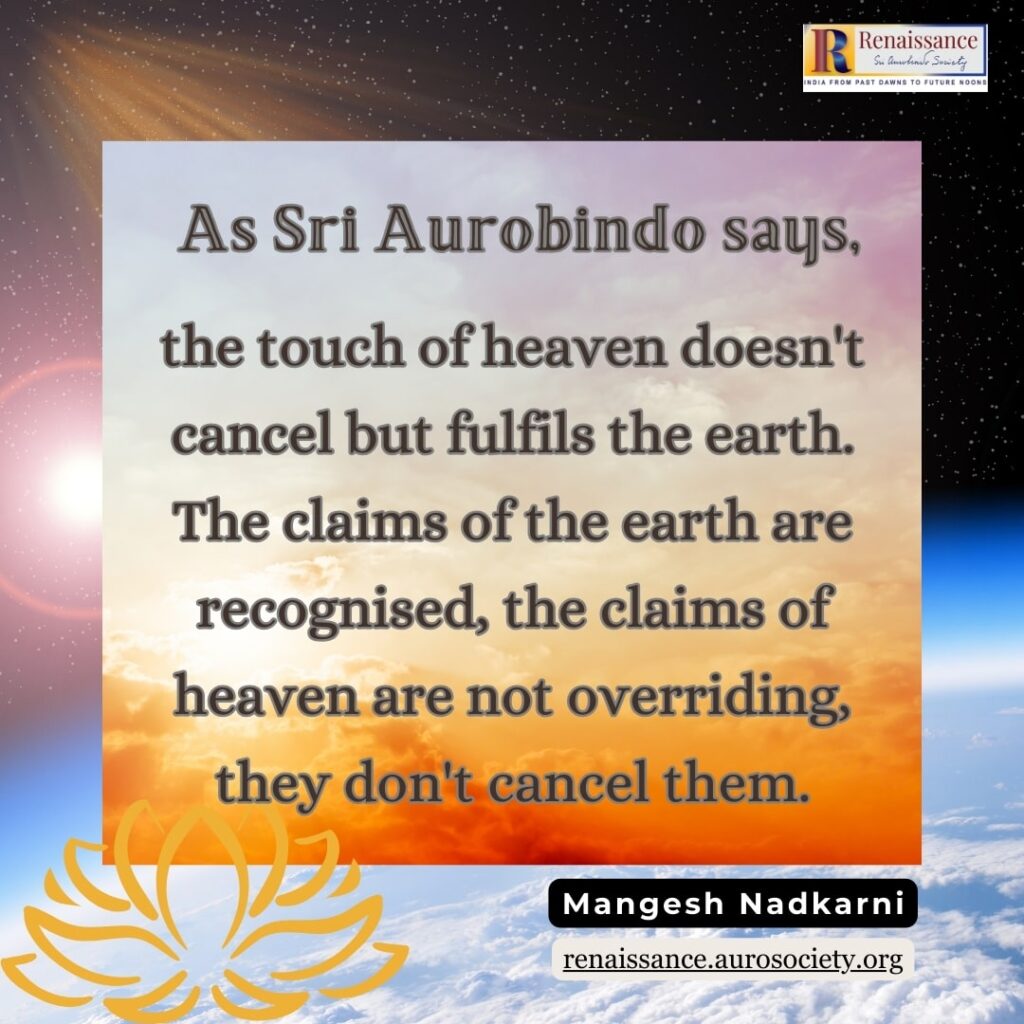
Savitri’s Mother and Book of Fate
The next major change is that Savitri’s mother is only mentioned by name by Vyasa, she has no particular role in the story. But in Sri Aurobindo’s Savitri she has a very important role.
When Savitri’s mother comes to know that Savitri has chosen this young man Satyavan who has just one year to live, she is flabbergasted like any mother. She is very anxious, very worried. She tries to dissuade Savitri from going ahead and asks her to go out once again and choose a second time.
And Savitri, of course, refuses to do that and is adamant: If one year is all I have with Satyavan, then one year is enough for me, she says.
Then Savitri’s mother, who is not named here but in the original Mahabharata story is called Malavi, turns to Narad. She asks him this basic fundamental question: What has Savitri done to deserve this misfortune? She is a young girl of 18, she has hurt nobody, she has done no harm, she has done no evil. Why then should her life be cursed? There are at this point of time at least a thousand eligible young men in this country. Why did Savitri’s chariot drive her just to this one young man who had only one year to live? What happened to the other 999 young men? Why didn’t the chariot go to any one of them?
In other words, what is this mysterious thing we call fate? Why does it strike us in the way it does? Why is it we have so much pain and suffering in this world? If God whom we describe as the ocean of kindness, as omniscient, as omnipotent, God who is so perfect, God who is the very definition of perfection, why has he created this imperfect world, this world which is a vale of tears and suffering? Couldn’t God have created a slightly better world? This is a question Savitri’s mother asks Narad.
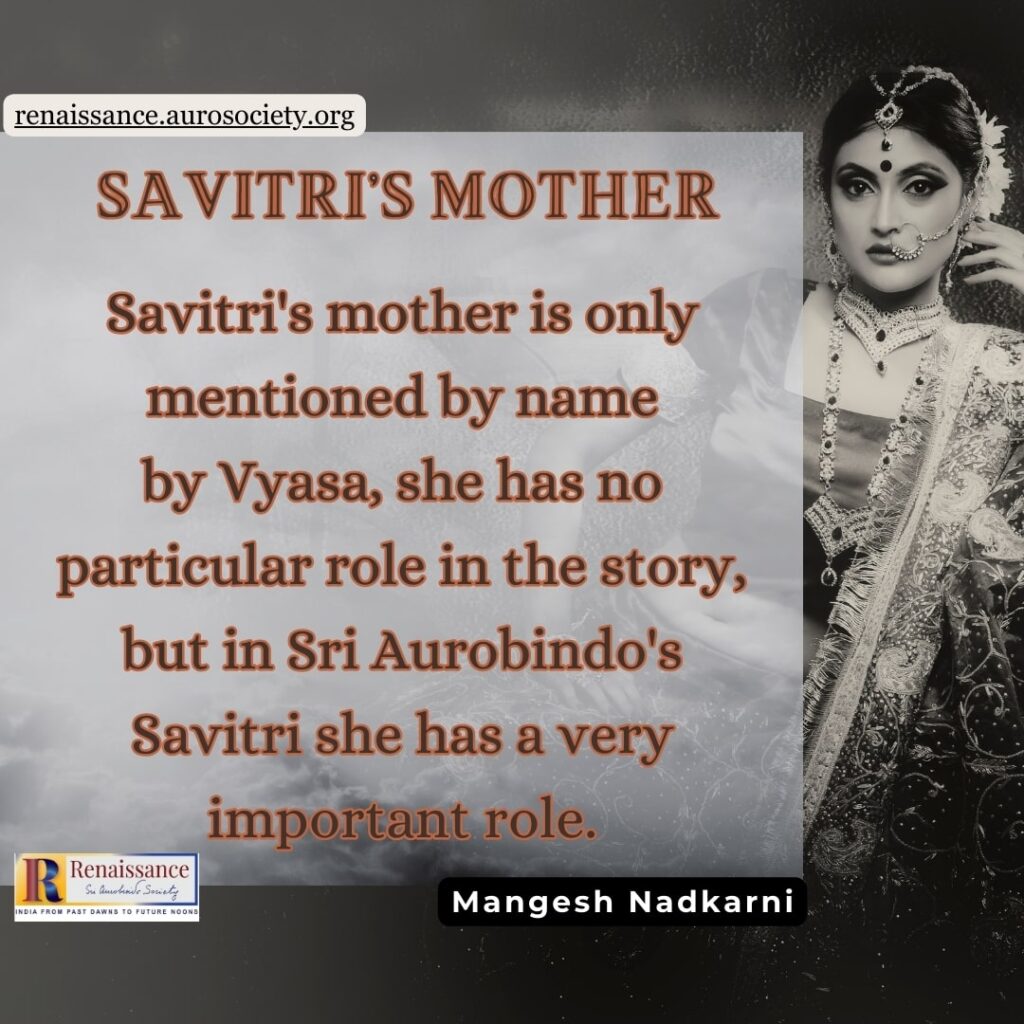
And Narad tries to explain how evil has come about, what is pain, how does it originate, what is its place. All this which Sri Aurobindo describes in great detail in The Life Divine in a metaphysical treatment, he takes up the same theme once again and analyses in the most poetic way. This is something you do not find in the original Mahabharata story.
TO BE CONTINUED…

Have you read PART 1?
~ Design: Beloo Mehra

